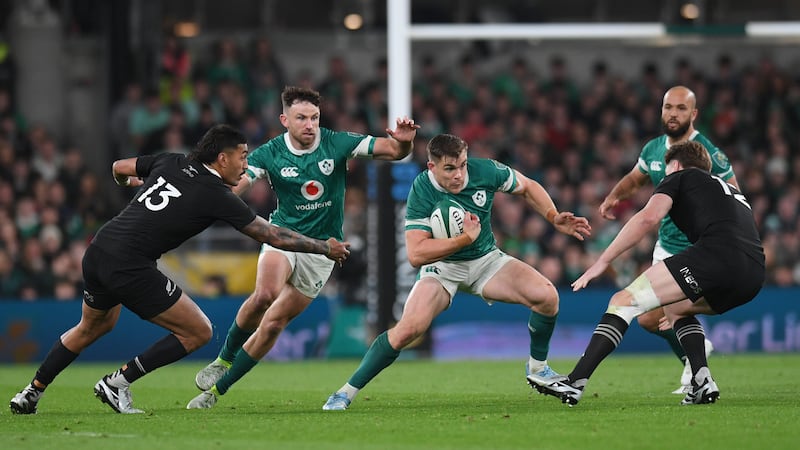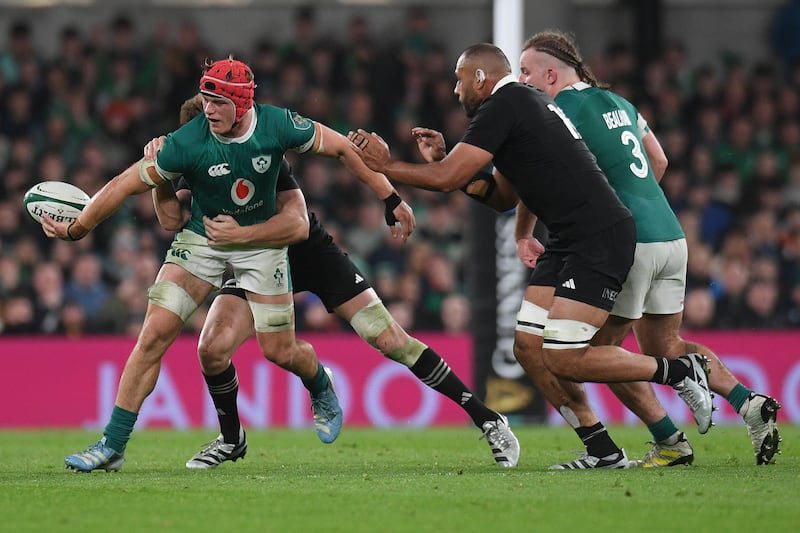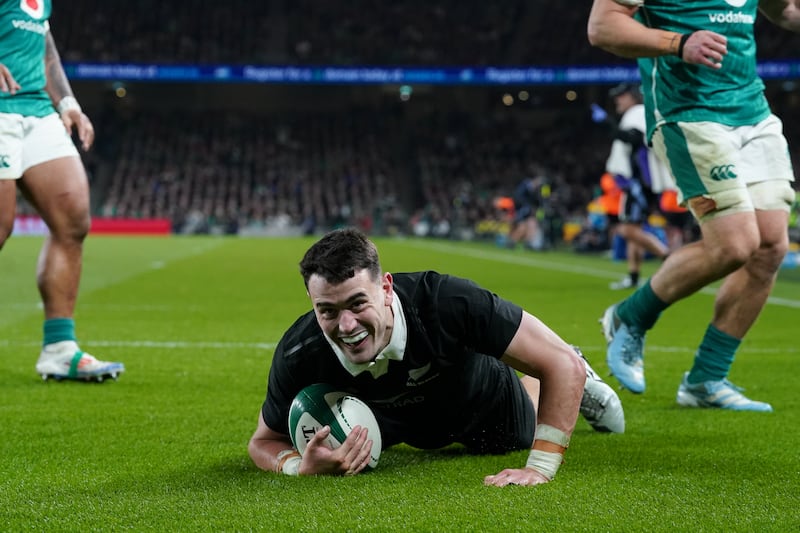It fizzled out to nothing, like a damp fuse on a firework. Ireland had waited 13 months since the World Cup quarter-final to give New Zealand a piece of their mind, but the words were stuck in their throat. The number one team in the world played well for about 10 minutes after half-time and everything else was just fumbling and fuming.
New Zealand may not be as strong now as they were at the World Cup, but to beat Ireland by 10 points here they only needed to be cute and competent. It is hard to remember when Ireland made so many mistakes in a big Test match. Every time they turned the key in the ignition and pressed on the accelerator they just flooded the engine. Going nowhere. Stuck.
How times have changed. The last time Ireland lost at Lansdowne Road was against France in February 2021, 20 matches ago. In the media, and elsewhere, Andy Farrell was being hammered. Billy Burns was at 10 – passing through – and very few people could understand yet what the Irish coach saw in Jamison Gibson-Park. One newspaper front page – taking a tone – declared that Farrell had “big questions to answer”.
“Our approach and our attitude doesn’t change,” said the Irish coach, calmly, steadfastly, stoically. Eleven players who saw action against France that day played in the Aviva on Friday. In the revolution, not that many heads rolled.
READ MORE
The difference, though, cannot be expressed simply in winning streaks or world rankings. Ireland expect to beat New Zealand now. There are no excuses and there is no menu of honourable alternatives, all of which makes the performance so hard to swallow. In the bloodstream of Irish rugby, New Zealand was the cholesterol we couldn’t shift. Despite a decade of better outcomes, the risk of a cardiac episode never went away.

The lights were dimmed for the prematch fireworks display before everyone had reached their seats. Fifteen minutes before kick-off was always going to cause a diary clash for elements of the Aviva crowd. For the haka, though, the stadium bristled like a Trump rally.
Ireland clearly decided to let the pageant play out before making a late show of passive resistance, but at the end of the crooked line of Irish players Peter O’Mahony went early, and took another couple of steps when he realised he was offside. Always a blindside.
Ireland tried to stake out their turf. In the first quarter the New Zealand half-backs were hit like clay pigeons. After only a few minutes Andrew Porter charged down a kick by Cortez Ratima, and tormented Damian McKenzie when he tried to sweep up the pieces.
Inside the first 20 minutes, Josh van der Flier and Gibson-Park, twice, nailed the New Zealand outhalf. If it was in the NFL the quarterback would be throwing dirty looks at his line backers. The sacks kept mounting.

All week there was talk of a needle between the teams and it didn’t take long to come to the surface. Joe McCarthy got stuck in and there was a flare-up. Maybe nobody was hit but the shaping was vicious. With immaculate comic timing, Paul Mescal’s face in the crowd was flashed up on the big screen, looking remarkably intact after his turn on Gladiator II.
The crowd burst into a lusty chorus of The Fields of Athenry and it felt for a minute like the game was going to explode. But it was a false start. There was too much kicking, and there were too many spillages, and too much of the game was being played in the Irish half, and there was scarcely a sniff of a try apart from Mark Tele’a nearly getting over in the corner.
The “no-escort” rule being trialled for the Autumn Series was designed to create cleaner aerial contests but the unintended consequence, in this game at least, was that both teams saw contestable kicks as not just an exit strategy but a more attractive attacking gambit.

At one stage in the first half Jack Crowley eschewed a shot at goal or a kick to touch from a penalty inside the New Zealand half in favour of a Garryowen. Ireland failed to recover the ball.
The problem for Ireland in the first half was that were too few entries into the New Zealand 22 and too many handling errors when they had engineered promising positions. Bundee Aki dropped one ball in midfield under no pressure and gave Caelan Doris an impossible pass at close quarters when there seemed to be a breakdown in communication or a timing issue. Either way, it was clumsy.
New Zealand’s possession in the first half hit 65 per cent which meant Ireland spent a lot of time scrambling and firing their bodies at invaders. Under that pressure, their discipline cracked and the penalties mounted. The visitors trailed to an early penalty from Jack Crowley but established a lead with three kicks at goal from McKenzie.
It wasn’t pretty or exhilarating and in many ways it was an old-fashioned Test match, characterised by full-blooded contests and slapstick mistakes. For Ireland to beat New Zealand while committing so many elementary errors would have been unimaginable at any other time in our Test history and that reality hasn’t changed.
Ireland were a little better in the second half, but not nearly as good as they wanted to be or needed to be. The tide turned for a while, either side of half-time. Jordie Barrett was sinbinned for a high tackle, and while New Zealand were reduced to 14 men, Ireland turned a six-point deficit into a four-point lead.
They started the second half with more aggression and menace and tempo than they had mustered at any time in the first half, and when they set up camp in the New Zealand 22 just after the break, they eventually made it pay. Josh van der Flier, the only Irish player to have played in all of Ireland’s five Test victories over the All Blacks, forced the ball on to the try-line.
That score put Ireland 13-9 ahead three minutes into the second half but they failed to score again. New Zealand continued to squeeze and Ireland continued to cough up penalties.
When the try finally arrived it came from a familiar source. The remarkable Will Jordan has now scored 34 tries in 39 Test matches, and five in his last five against Ireland. It was too much like old times.
- Sign up for push alerts and have the best news, analysis and comment delivered directly to your phone
- Join The Irish Times on WhatsApp and stay up to date
- Listen to our Inside Politics podcast for the best political chat and analysis















